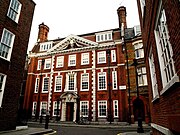Career
He trained as an architect at the Glasgow firm of John Burnet, then under Robert William Edis of London. Field was not inspired by Edis's work, but developed great admiration and respect for Richard Norman Shaw, architect and neighbour in Hampstead, who he knew socially – both for his work and as an example of humanity.
Field started his own practice in 1882, as Field and Moore, together with his father's assistant Edwin Emmanuel Moore; their first work was Wedderburn House (1884–5), a six-storey block of flats in Hampstead; Wedderburn Cottage (1886) followed adjacent.
In 1887 he married Mary Frances Campbell, daughter of James Campbell at St James Episcopal Church, Leith. [3] He joined the Art Workers Guild in 1889. "The Hoo" (17, Lyndhurst Gardens) in Camden was built 1890, and further properties at Nos. 19–21 Lyndhurst Road in 1898.
In 1890 Field took on Michael Bunney as a trainee; Bunney became Field's chief assistant, until 1902, when he formed his own practice. Together they wrote English domestic architecture of the XVII and XVIII centuries. Field's first commercial business client was Lloyds Bank who commissioned bank buildings at Hampstead c.1895; subsequently Lloyds used Field as architect over a 30-year period.
In 1898 the North Eastern Railway (NER) chose Field as architect for their new main headquarters in York, now the Grand hotel. Working with William Bell the company's architect, whose input was mainly structural or contractual, the office buildings were constructed between 1900 and 1906, with Field receiving £1,750 payment for his work. Field also received the commission to design the NER's London offices at 4 Cowley Street, Westminster, his plans were submitted 1904 and the building completed 1906.
In 1899 Evelyn Simmons joined the practice, initially being articled, then assistant and finally in partnership from 1905 to 1915. Simmons family connections brought work in Hampstead Garden Suburb and co-operation with Amos Faulkner, Simmons's brother-in-law and son of Charles Joseph Faulkner. Amos was architect for the builders William Willett and Son, for whom the practice produced designs for several large London houses, and apartments.
Mary Field's friendship with Elizabeth Garrett Anderson and her circle of friends led to him becoming the consulting architect to the New Hospital for Women on Euston Road from 1888 to 1905, where he designed a nurses home (now demolished) at the rear of the building. [8]
Field left the Art Workers' Guild in 1903 and joined RIBA in 1906.
He was a keen golfer, which led to many commissions for "golf cottages" (the term then used for houses close to golf courses) near Woking, Surrey and Aldeburgh, Suffolk, where he also designed the Aldeburgh Golf Club house in 1911, a replacement for an earlier building by J. M. Brydon destroyed by fire. [9]
Later life
He continued in practice until 1931, retiring to Rye in 1932, where he undertook a few commissions for small house designs and alterations. His last built design was in 1941, as a favour for his cousin Daisy Field, at Great Dixter, for a conversion of a store attached to the oasthouse into a cow house. [10]
He died on 16 June 1948 and is buried with his wife Mary Frances (1859-1950) in the churchyard at St Michael's Playden, Sussex.
This page is based on this
Wikipedia article Text is available under the
CC BY-SA 4.0 license; additional terms may apply.
Images, videos and audio are available under their respective licenses.





